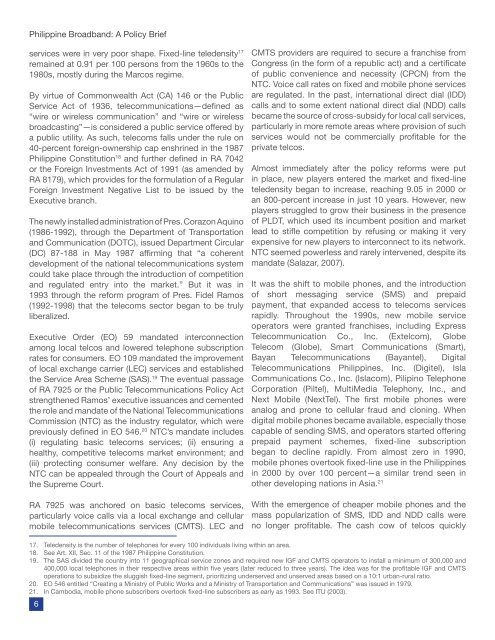Philippine Broadband A Policy Brief
ONLINE-BROADBAND-POLICY-BRIEF1
ONLINE-BROADBAND-POLICY-BRIEF1
You also want an ePaper? Increase the reach of your titles
YUMPU automatically turns print PDFs into web optimized ePapers that Google loves.
<strong>Philippine</strong> <strong>Broadband</strong>: A <strong>Policy</strong> <strong>Brief</strong><br />
services were in very poor shape. Fixed-line teledensity 17<br />
remained at 0.91 per 100 persons from the 1960s to the<br />
1980s, mostly during the Marcos regime.<br />
By virtue of Commonwealth Act (CA) 146 or the Public<br />
Service Act of 1936, telecommunications—defined as<br />
“wire or wireless communication” and “wire or wireless<br />
broadcasting”—is considered a public service offered by<br />
a public utility. As such, telecoms falls under the rule on<br />
40-percent foreign-ownership cap enshrined in the 1987<br />
<strong>Philippine</strong> Constitution 18 and further defined in RA 7042<br />
or the Foreign Investments Act of 1991 (as amended by<br />
RA 8179), which provides for the formulation of a Regular<br />
Foreign Investment Negative List to be issued by the<br />
Executive branch.<br />
The newly installed administration of Pres. Corazon Aquino<br />
(1986-1992), through the Department of Transportation<br />
and Communication (DOTC), issued Department Circular<br />
(DC) 87-188 in May 1987 affirming that “a coherent<br />
development of the national telecommunications system<br />
could take place through the introduction of competition<br />
and regulated entry into the market.” But it was in<br />
1993 through the reform program of Pres. Fidel Ramos<br />
(1992-1998) that the telecoms sector began to be truly<br />
liberalized.<br />
Executive Order (EO) 59 mandated interconnection<br />
among local telcos and lowered telephone subscription<br />
rates for consumers. EO 109 mandated the improvement<br />
of local exchange carrier (LEC) services and established<br />
the Service Area Scheme (SAS). 19 The eventual passage<br />
of RA 7925 or the Public Telecommunications <strong>Policy</strong> Act<br />
strengthened Ramos’ executive issuances and cemented<br />
the role and mandate of the National Telecommunications<br />
Commission (NTC) as the industry regulator, which were<br />
previously defined in EO 546. 20 NTC’s mandate includes<br />
(i) regulating basic telecoms services; (ii) ensuring a<br />
healthy, competitive telecoms market environment; and<br />
(iii) protecting consumer welfare. Any decision by the<br />
NTC can be appealed through the Court of Appeals and<br />
the Supreme Court.<br />
RA 7925 was anchored on basic telecoms services,<br />
particularly voice calls via a local exchange and cellular<br />
mobile telecommunications services (CMTS). LEC and<br />
CMTS providers are required to secure a franchise from<br />
Congress (in the form of a republic act) and a certificate<br />
of public convenience and necessity (CPCN) from the<br />
NTC. Voice call rates on fixed and mobile phone services<br />
are regulated. In the past, international direct dial (IDD)<br />
calls and to some extent national direct dial (NDD) calls<br />
became the source of cross-subsidy for local call services,<br />
particularly in more remote areas where provision of such<br />
services would not be commercially profitable for the<br />
private telcos.<br />
Almost immediately after the policy reforms were put<br />
in place, new players entered the market and fixed-line<br />
teledensity began to increase, reaching 9.05 in 2000 or<br />
an 800-percent increase in just 10 years. However, new<br />
players struggled to grow their business in the presence<br />
of PLDT, which used its incumbent position and market<br />
lead to stifle competition by refusing or making it very<br />
expensive for new players to interconnect to its network.<br />
NTC seemed powerless and rarely intervened, despite its<br />
mandate (Salazar, 2007).<br />
It was the shift to mobile phones, and the introduction<br />
of short messaging service (SMS) and prepaid<br />
payment, that expanded access to telecoms services<br />
rapidly. Throughout the 1990s, new mobile service<br />
operators were granted franchises, including Express<br />
Telecommunication Co., Inc. (Extelcom), Globe<br />
Telecom (Globe), Smart Communications (Smart),<br />
Bayan Telecommunications (Bayantel), Digital<br />
Telecommunications <strong>Philippine</strong>s, Inc. (Digitel), Isla<br />
Communications Co., Inc. (Islacom), Pilipino Telephone<br />
Corporation (Piltel), MultiMedia Telephony, Inc., and<br />
Next Mobile (NextTel). The first mobile phones were<br />
analog and prone to cellular fraud and cloning. When<br />
digital mobile phones became available, especially those<br />
capable of sending SMS, and operators started offering<br />
prepaid payment schemes, fixed-line subscription<br />
began to decline rapidly. From almost zero in 1990,<br />
mobile phones overtook fixed-line use in the <strong>Philippine</strong>s<br />
in 2000 by over 100 percent—a similar trend seen in<br />
other developing nations in Asia. 21<br />
With the emergence of cheaper mobile phones and the<br />
mass popularization of SMS, IDD and NDD calls were<br />
no longer profitable. The cash cow of telcos quickly<br />
17. Teledensity is the number of telephones for every 100 individuals living within an area.<br />
18. See Art. XII, Sec. 11 of the 1987 <strong>Philippine</strong> Constitution.<br />
19. The SAS divided the country into 11 geographical service zones and required new IGF and CMTS operators to install a minimum of 300,000 and<br />
400,000 local telephones in their respective areas within five years (later reduced to three years). The idea was for the profitable IGF and CMTS<br />
operations to subsidize the sluggish fixed-line segment, prioritizing underserved and unserved areas based on a 10:1 urban-rural ratio.<br />
20. EO 546 entitled “Creating a Ministry of Public Works and a Ministry of Transportation and Communications” was issued in 1979.<br />
21. In Cambodia, mobile phone subscribers overtook fixed-line subscribers as early as 1993. See ITU (2003).<br />
6


